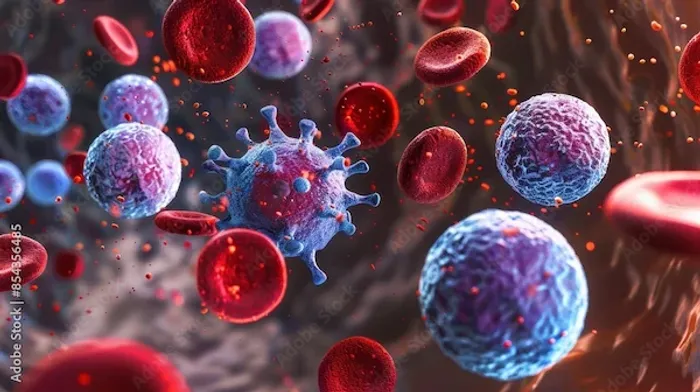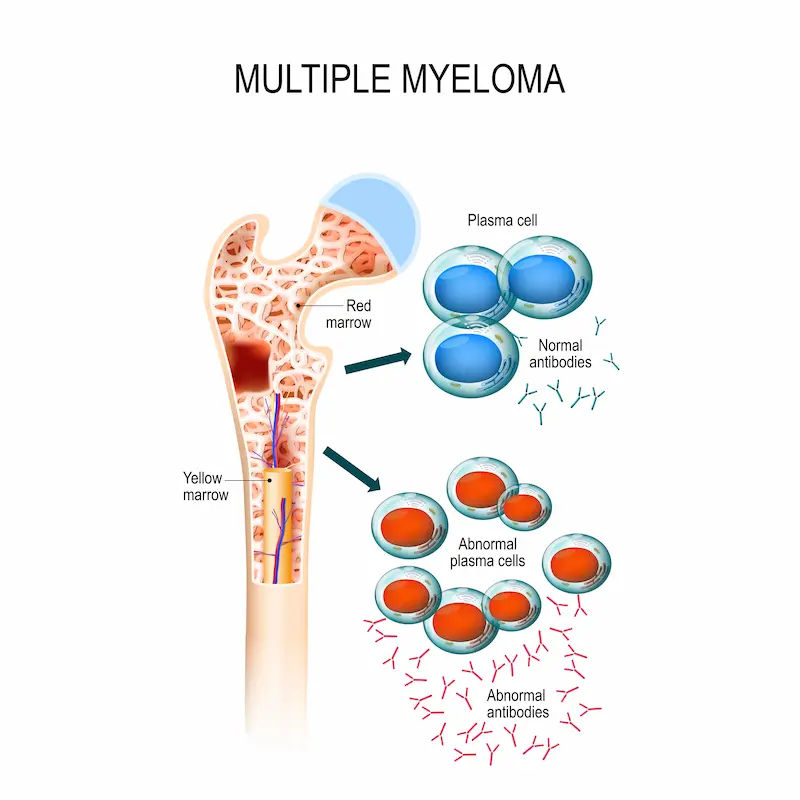Multiple Myeloma: Symptoms and Treatment Options
Learn about multiple myeloma, including its symptoms, causes, and treatment options, to understand this type of blood cancer and its management.

Written by Dr. J T Hema Pratima
Reviewed by Dr. Dhankecha Mayank Dineshbhai MBBS
Last updated on 9th Sep, 2025

Introduction
Multiple myeloma is a complex blood cancer that begins in the plasma cells, a type of white blood cell found in your bone marrow. While it remains a serious condition, the landscape of multiple myeloma treatment options has transformed dramatically over the past two decades, turning what was once a rapidly fatal disease into a manageable chronic illness for many patients. This progress hinges on early detection and personalised therapy. The challenge lies in its symptoms, which are often vague, easily mistaken for normal aches or other common ailments. This article will guide you through the critical early signs of multiple myeloma you should never ignore, demystify the diagnostic process, and provide a comprehensive overview of the modern, effective treatment options available today. Understanding these facets is the first step toward empowerment and proactive health management.
Early Warning Signs: Listening to Your Body's Signals
Multiple myeloma often announces itself not with a single dramatic symptom, but with a constellation of subtle changes. The most classic symptoms are summarised by the acronym CRAB, which stands for elevated Calcium, Renal failure, Anaemia, and Bone lesions.
The CRAB Criteria: Defining Myeloma-Related Damage
C - High Calcium Levels (Hypercalcaemia): As myeloma cells damage bones, they release excess calcium into the bloodstream. This can cause extreme thirst, frequent urination, dehydration, constipation, severe abdominal pain, confusion, and even kidney failure.
R - Renal Failure (Kidney Problems): The abnormal antibodies produced by myeloma cells (M-proteins) can damage the kidneys, impairing their ability to filter waste. This may present as weakness, shortness of breath, itching, and swelling in the legs.
A - Anaemia: When cancerous plasma cells overcrowd the bone marrow, they crowd out healthy red blood cell production. This leads to anaemia, causing persistent fatigue, weakness, dizziness, paleness, and shortness of breath even with mild activity.
B - Bone Problems: Myeloma cells activate cells that break down bone, leading to pain, often in the back, ribs, or skull. This pain is typically persistent and worse at night. These "lytic lesions" weaken the bones, making them prone to fractures from minor stress or even spontaneously.
Beyond CRAB: Other Common but Less Specific Symptoms
Other symptoms of multiple myeloma include:
Frequent Infections: The overproduction of faulty antibodies compromises the immune system's ability to fight normal pathogens, leading to repeated infections like pneumonia.
Numbness or Weakness: A less common but serious complication is spinal cord compression from a collapsed vertebra, which is a medical emergency.
Unexplained Weight Loss and general malaise.
If you are experiencing a combination of these symptoms of multiple myeloma, especially persistent bone pain or unexplained fatigue, it is crucial to seek professional evaluation. If symptoms persist beyond two weeks, consult a doctor online with Apollo24|7 for further evaluation.
Consult a Haemato Oncologist for the best advice
How is Multiple Myeloma Diagnosed?
Diagnosis often begins with routine blood work that reveals unexplained anaemia or high protein levels. A formal diagnostic workup is comprehensive.
Essential Blood and Urine Tests
Blood tests check for anaemia, calcium levels, kidney function, and specifically measure the levels of abnormal M-protein. Urine tests often look for Bence Jones proteins, which are fragments of M-proteins that can damage kidneys. Apollo24|7 offers convenient home collection for tests like serum protein electrophoresis, which are key in this process.
Imaging Scans: Seeing the Whole Picture
X-rays, CT, MRI, or PET scans are used to survey the skeleton for lytic lesions, fractures, or the presence of plasmacytomas (tumors of plasma cells).
The Bone Marrow Biopsy: The Definitive Test
Performed typically on the hip bone, this test involves extracting a small sample of bone marrow to determine the percentage of cancerous plasma cells. This is essential for confirming the diagnosis.
Get Your Health Assessed
Staging and Risk Stratification: Planning Your Treatment Path
Once diagnosed, myeloma is staged using the Revised International Staging System (R-ISS), which incorporates blood test results, genetic abnormalities in the cancer cells (cytogenetics), and LDH levels. This staging doesn't just predict outlook; it directly guides the choice of therapy for multiple myeloma. "High-risk" cytogenetics, for example, may warrant a more aggressive treatment approach from the start.
A Multifaceted Approach: Modern Multiple Myeloma Treatment Options
Today's treatment is highly personalised. The initial approach for eligible patients is typically induction therapy followed by autologous stem cell transplantation and then maintenance therapy.
Standard of Care: Combination Drug Therapies
Most patients receive a combination of drugs from different classes to attack the cancer in multiple ways.
Proteasome Inhibitors (PIs)
Drugs like bortezomib work by causing a buildup of toxic proteins in the myeloma cells, leading to their death.
Immunomodulatory Drugs (IMiDs)
Lenalidomide and pomalidomide enhance the body's own immune cells to identify and kill myeloma cells and also cut off the tumor's blood supply.
Monoclonal Antibodies
A groundbreaking class of treatment, drugs like daratumumab (an anti-CD38 antibody) are designed to seek out and bind to specific antigens on myeloma cells, flagging them for destruction by the immune system.
Stem Cell Transplantation: A Chance for Deeper Remission
For eligible patients, high-dose chemotherapy is used to wipe out the bone marrow, followed by an infusion of the patient's own previously collected healthy stem cells (autologous transplant) to rescue the bone marrow. This is not a cure but can lead to very long periods of remission.
The New Frontier: CAR T-Cell Therapy and Bispecific Antibodies
These are revolutionary immunotherapy options for relapsed myeloma. CAR T-cell therapy involves engineering a patient's own T-cells to recognize and attack myeloma cells. Bispecific antibodies act as a bridge, connecting T-cells directly to myeloma cells to trigger cell death.
Managing Side Effects and Supportive Care
Treatment is also focused on managing complications. This includes:
Bisphosphonates: Drugs to strengthen bones and reduce fracture risk.
Erythropoietin: To stimulate red blood cell production and combat anaemia.
Blood transfusions and growth factors to support blood counts.
Pain management and antibiotics to prevent infections.
Living with Multiple Myeloma: Monitoring and Long-Term Outlook
Myeloma is often characterized by periods of remission and relapse. After initial treatment, patients enter a maintenance phase, often with a low-dose oral drug, to prolong remission. Regular monitoring via blood tests and occasional scans is the standard. The prognosis for multiple myeloma has improved vastly, with many patients living active lives for a decade or more after diagnosis, thanks to the continuous development of new treatment options.
Conclusion: Empowerment Through Knowledge and Expert Care
The journey with multiple myeloma is undeniably challenging, but it is no longer without hope or effective strategies. Recognising the early signs of multiple myeloma, particularly the CRAB symptoms, is the critical first step that can lead to a timely diagnosis. From there, a vast and growing arsenal of treatment options, from targeted combination therapies to cutting-edge immunotherapies, offers the potential for long-term disease control and a high quality of life. The key is a personalised treatment plan developed with a specialist. If you or a loved one are navigating concerns related to myeloma, remember that you are not alone.
Consult a Haemato Oncologist for the best advice
Consult a Haemato Oncologist for the best advice

Dr. Sanchayan Mandal
Medical Oncologist
17 Years • MBBS, DNB Raditherapy, DrNB Medical Oncology
East Midnapore
VIVEKANANDA SEBA SADAN, East Midnapore

Dr.sanchayan Mandal
Medical Oncologist
17 Years • MBBS, DrNB( MEDICAL ONCOLOGY), DNB (RADIOTHERAPY),ECMO. PDCR. ASCO
Kolkata
Dr. Sanchayan Mandal Oncology Clinic, Kolkata

Dr Minakshi Bansal
Paediatric Haematologist
8 Years • MBBS, MD PEDIATRICS, FIAP (PHO)
Delhi
Apollo Hospitals Indraprastha, Delhi
(25+ Patients)

Dr. Rupam Manna
Radiation Specialist Oncologist
4 Years • MBBS MD(RADIO THERAPY)
Barasat
Diab-Eat-Ease, Barasat

Dr. Shishir Seth
Haemato Oncologist
20 Years • MBBS, MD, DM (Clinical Hematology)
Delhi
Apollo Hospitals Indraprastha, Delhi
(75+ Patients)
More articles from Multiple Myeloma
Frequently Asked Questions
1. What is the life expectancy for someone diagnosed with multiple myeloma today?
While outcomes vary greatly based on age, overall health, and genetic risk factors, advances in treatment have significantly extended life expectancy. Many patients now live 7-10 years or more after diagnosis, with some living for over two decades, transforming myeloma into a manageable chronic condition for many.
2. What is the difference between MGUS and multiple myeloma?
MGUS (Monoclonal Gammopathy of Undetermined Significance) is a benign, pre-cancerous condition where abnormal M-protein is present but at low levels, with no symptoms or organ damage. It requires monitoring but not treatment. A small percentage of MGUS cases can progress to multiple myeloma or related cancers over many years.
3. Is stem cell transplantation a cure for multiple myeloma?
Currently, no treatment is considered a definitive cure for multiple myeloma. However, an autologous stem cell transplant is a highly effective treatment that can lead to very deep and long-lasting remissions, often lasting several years. It remains a standard of care for eligible patients.
4. What are the common side effects of multiple myeloma chemotherapy?
Common side effects depend on the specific drugs but can include fatigue, lowered blood counts (increasing infection risk), nausea, peripheral neuropathy (numbness or tingling in hands and feet), and an increased risk of blood clots. Your medical team will provide proactive management strategies for these side effects.
5. Can multiple myeloma be prevented?
There is no known way to prevent multiple myeloma. Since the causes are largely unknown and risk factors like age, race, and family history are not modifiable, the best approach is awareness of the early symptoms and seeking prompt medical attention if they arise, leading to earlier diagnosis and more effective treatment.

